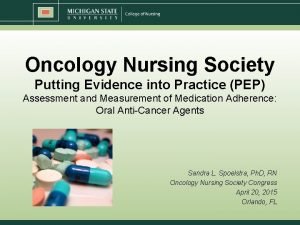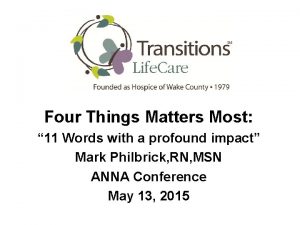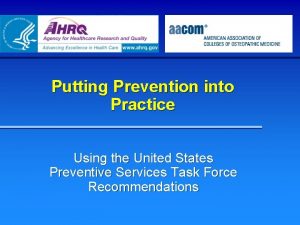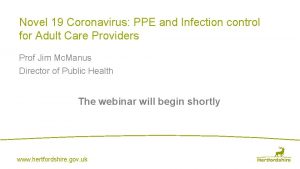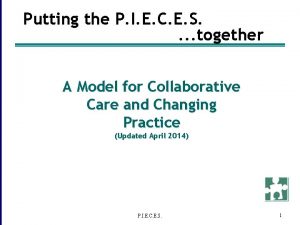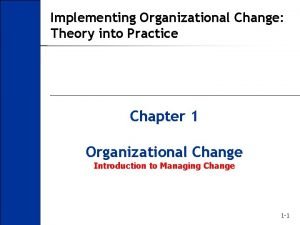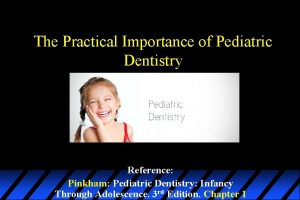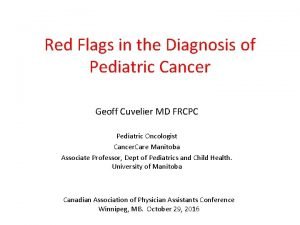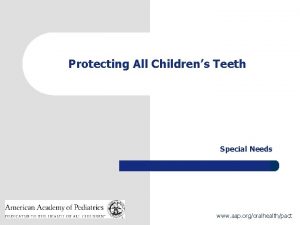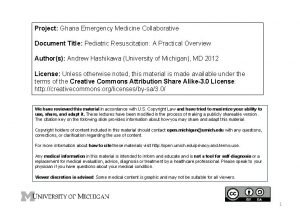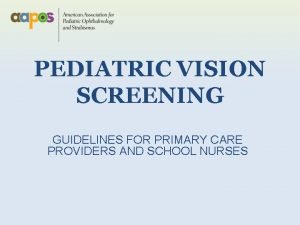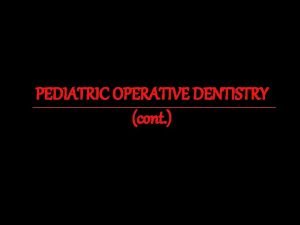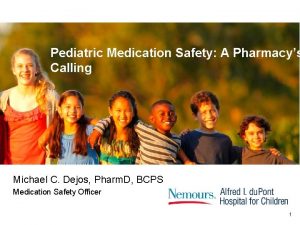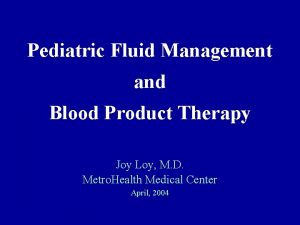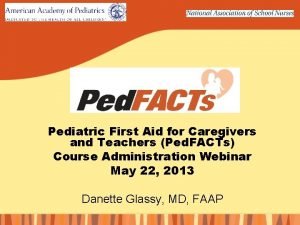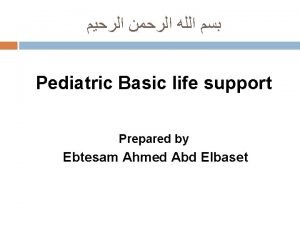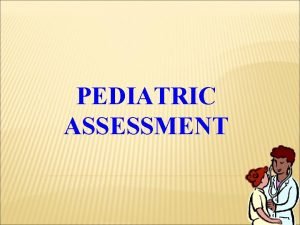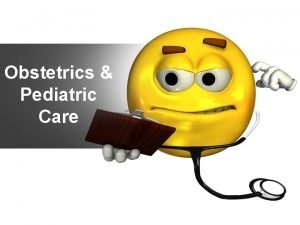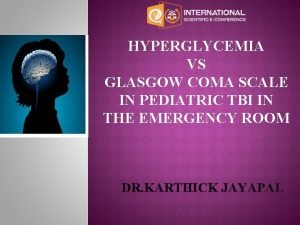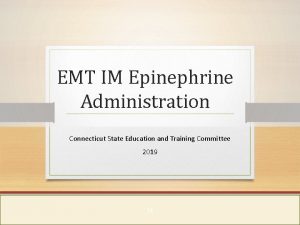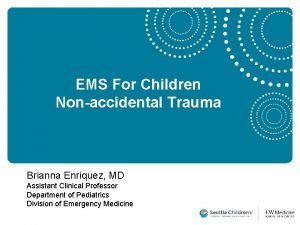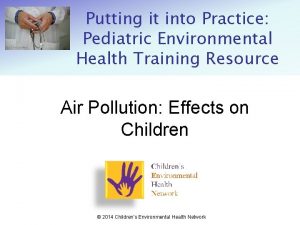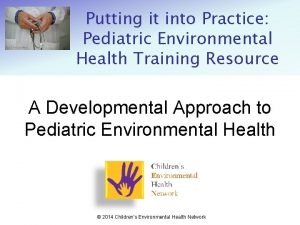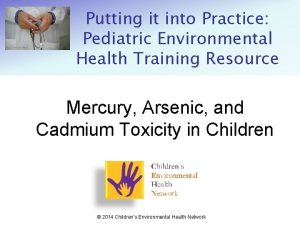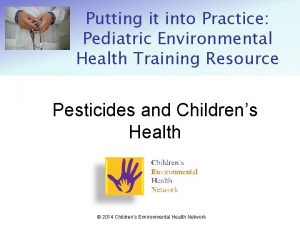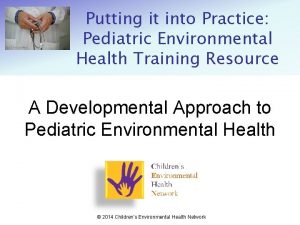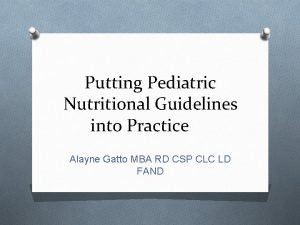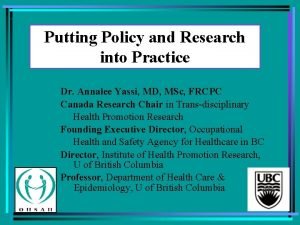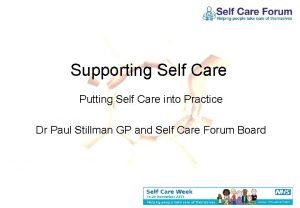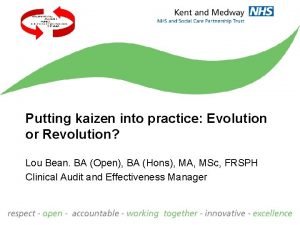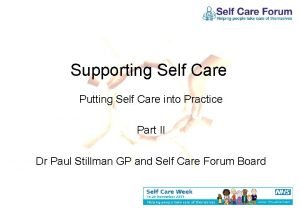Alex E Proimos Putting it into Practice Pediatric




































































- Slides: 68

Alex E. Proimos Putting it into Practice: Pediatric Environmental Health Training Resource Endocrine Disrupting Chemicals and Children’s Health: Phthalates and Bisphenol A © 2014 Children’s Environmental Health Network

Author This presentation was developed by: Maida P Galvez MD, MPH Icahn School of Medicine at Mount Sinai “Putting it into Practice: Pediatric Environmental Health Training Resource” made possible by support from the W. K. Kellogg Foundation Image in slide #1 courtesy of Alex E. Proimos/Flickr, used under Creative Commons Attribution-Non. Commercial 4. 0 International License: http: //creativecommons. org/licenses/by-nc/4. 0/legalcode

Learning Objectives The overall goals of the workshop are to: • Educate pediatric providers about two endocrine disrupting chemicals • Share principles of risk communication with respect to developing environmental health messages

What are Endocrine Disruptors? • Endocrine disruptors interfere with endocrine system function • Mimic, block, alter synthesis, metabolism or excretion of hormones – Setting off similar chemical reactions in the body – Prevent the action of normal hormones – Alter the concentrations of natural hormones Damstra, T. et al. International Programme on Chemical Safety, 2002.


Examples of Endocrine Disrupting Chemicals • Pesticides: DDT/DDE (See also the “Pesticides” module*) • Organohalogens: PCBs, PBDEs, Dioxins (See also the “Persistant Organic Pollutants” module*) • Heavy Metals: Lead, Mercury, Cadmium (See also the “Childhood Lead Poisoning” and the “Mercury, Arsenic, and Cadmium Toxicity in Children” modules*) • Plastics/Plasticizers: Phthalates and BPA *Additional modules in CEHN’s Pediatric Training Resource

Risk Factors through the Lifespan Pregnancy Birth Infancy Childhood Adolescence Adulthood

Plastics Are Everywhere Plasticizers impart flexibility and durability – Phthalates are anti-androgenic • 200 million pounds of DEHP was produced in 2002 – Bisphenol A is a weak estrogen • 2. 3 billion pounds of BPA was produced in 2004 Wargo et al. Environment and Human Health, Inc. 2008.

Plastics Are Everywhere Baby shampoo study raises chemical concerns Phthalates found in urine of infants after they were powdered or lotioned

www. nottoopretty. org

What Parents Ask § How do I know if toys contain phthalates? § Are bottles with bisphenol A harmful? § What are the current regulations? § What health effects should I look for? § What alternatives can my child use?

Where are Phthalates found?


Where are Phthalates found? (continued) Product Phthalate Metabolite Foods Toys Medical supplies DEHP: di-(2 -ethylhexyl) phthalate MEHP: mono-(2 -ethylhexyl) phthalate MEOHP: Mono(2 -ethy-5 -oxolhexyl) phthalate MEHHP: Mono(2 -ethyl-5 -hydroxyhexyl) phthalate MECPP: Mono(2 -ethy-5 -carboxypentyl) phthalate Toys DINP: di-isononyl phthalate MINP: monoisononyl phthalate MCIOP: mono(carboxy-isooctyl) phthalate MOINP: mono(oxoisononyl)phthalate MHINP: mono (hydroxy-isononyl)phthalate MIDP: monoisodecyl phthalate Mn. OP: : mono-n-octyl phthalate DIDP: di-isodecyl phthalate DNOP: Di-n-octylphthalate

Where are Phthalates found? (continued) Product PVC, vinyl floors, cosmetics Phthalate BBz. P: benzyl butyl phthalate DEHP: di-(2 -ethylhexyl) phthalate Cosmetics: DEP: diethyl phthalate nail polish and DBP: dibutyl phthalate perfumes DMP: dimethyl phthalate Metabolite MBz. P: monobenzyl phthalate MEHP: mono-(2 -ethylhexyl) phthalate MEOHP: Mono(2 -ethy-5 -oxolhexyl) phthalate MEHHP: Mono(2 -ethyl-5 -hydroxyhexyl) phthalate MECPP: Mono(2 -ethy-5 -carboxypentyl) phthalate MEP: monoethyl phthalate MBP: monobutyl phthalate

Centers for Disease Control (CDC) 4 th Report on Human Exposures Geometric Means of Phthalates (ug/g creatinine) by age PHTHALATE m. Bz. P m. EHP m. EOHP m. EHHP m. EP m. BP mi. BP 6 -11 yo 12 -19 yo 20 yo+ 35. 8 3 26. 6 39 96. 9 38. 4 6. 94 16. 6 2. 07 14. 6 21. 2 168 20 3. 4 11 2. 14 12. 4 18. 8 197 18. 3 3. 3

Phthalates Findings • Animal studies demonstrate that the male reproductive tract is particularly sensitive to the anti-androgenic effects of phthalates

Summary of Findings In animal studies there is evidence of: – Adverse birth outcomes – Reproductive toxicity – Male reproductive tract particularly sensitive Human studies: – Alterations in hormone levels – Male Infertility – Asthma, puberty and body size – Prenatal exposure and • decreased anogenital distance • neurodevelopment

Phthalates Syndrome Anti-Androgen Effects – – – Hypospadias Undescended Testes Fetal Germ Cell Effects Infertility Decreased Anogenital Distance Foster PMD, Int J Androl, 2006.

Anogenital Distance n=169 Sathyanarayana et al. Int J of Androl, 2009.

Decreased anogenital distance is a measure of anti-androgen exposure n=85 Anogenital Distance is normally twice as long in males as in females Swann et al. Environ Health Perspect, 2005.

Phthalates & Testicular Descent in Humans n=85 AGD Category Short Percent with Incomplete Testicular Descent 20. 0% Intermediate 9. 5% Long 5. 9% P<0. 001 Swan SH et al. Environ Health Perspect, 2005.

Postnatal Exposures Phthalates in breast milk and serum hormone levels in male offspring, n=130 • Adverse effect on Leydig cell function: – Elevated LH levels – decreased free testosterone – elevated LH: free testosterone ratio • Indirect sign of reduced androgen activity: – Increased SHBG Main et al. Environ Health Perspect, 2006.

Phthalates Exposures in Infants Measured phthalates in 163 infants (2 -28 mos) born in 2000– 2005 – Lotion predictive of monoethyl phthalate and monomethyl phthalate concentrations – Powder of monoisobutyl phthalate – Shampoo of monomethyl phthalate – More products used= higher exposure Sathyanarayana et al, Pediatrics, 2008.

Prenatal Exposures 3 rd Trimester maternal phthalates and neonatal behavior in NYC (n=295) • NYC Pregnancy Cohort assessed Brazelton Neonatal Behavioral Assessment Scale (BNBAS) • Among girls, there was a significant linear decline in adjusted mean orientation score with increasing high molecular weight phthalate metabolites (B=-0. 37, p=0. 02) • Strong linear decline in adjusted mean Quality of Alertness score (B=-0. 48, p<0. 01) Engel et al. Neurotoxicology, 2009.

Prenatal Phthalates Exposures and Child Neurodevelopment (n=188) • Same cohort with f/u visits between 4 -9 years of age, BRIEF and BASC administered. • Evidence of dose-response effect of Prenatal LMW Phthalate Exposure on behavioral problems in childhood. • Patterns of association overlap with domains affected in childhood Conduct Disorder and ADHD clinical groups. • Limitations: Small sample size (n=188), Needs to be replicated in independent cohorts. • If replicated, preventive measures to reduce exposure during pregnancy may be warranted. Engel et al. Environ Health Perspect, 2010.

Phthalates Legislation l - European Union 2005 3 banned in all toys/child-care products 3 banned in toys/child-care products that can be mouthed California Phthalates Ban 2009 6 phthalates banned in toys/child-care products prohibits manufacture, sale, and distribution

Consumer Product Safety Improvement Act of 2008 • Federal legislation: mandatory third party safety testing and certification of all toys and products marketed to children <12 years old • It includes a ban on phthalates in toys and children’s products: DEHP, DBP and BBP • Interim ban on the use of three other phthalates: DINP, DIDP and Dn. OP

European Union 2003 • Phthalates DEHP, DBP and BBP are all prohibited from use in cosmetics due to their classification as substances that are potentially carcinogenic, mutagenic or reproductive toxicants.

California Safe Cosmetics Act of 2005 • Manufacturers that sell over $1 million a year in personal-care products • Report any products containing a chemical that is either a carcinogen or a reproductive or developmental toxic agent. • Phthalates: DEHP and DBP

EPA Action Plan 2009 • Coordinated approach with the Consumer Product Safety Commission (CPSC) and the Food and Drug Administration (FDA) • – – – Intends to initiate action to address the Manufacturing Processing Distribution in commerce and/or use

What Can You Do to Reduce Phthalates Exposures? Precautionary Approach: • Eat fresh foods • Avoid use in microwave • Avoid use in dishwasher • Wet mop and dust frequently • Seek phthalates free labels • Keep it simple, less is more • www. cosmeticsdatabase. org

Look to recycling labels #3 plastics can contain phthalates

Pocket Guide to Plastics Front of card Back of card

Bisphenol A (BPA)

BPA Exposures are Widespread • NHANES 2003 -2004 Calafat et al. – US population ages 6 -85 years (n=2517) – BPA present in 93% of population – Children 6 -11 years (n=217) • Geometric mean BPA=4. 3 ug/gram creatinine • Children >6 years old (p < 0. 001) and adolescents (p < 0. 003) had higher levels than adults

Summary of Findings BPA is a weak estrogen • Animal studies: – – Adverse birth outcomes Male reproductive tract Early pubertal development Increased body size • Human studies: – – – Prenatal exposure and neurodevelopment Prenatal exposure and wheeze in children Cardiovascular disease, Type 2 Diabetes, Obesity Liver function (GGT, LDH, Alk Phos) Childhood Obesity Cancer classification controversial

Prenatal BPA and early childhood behavior in 2 year olds n=249 • Maternal urine collected from 16 -26 weeks – Behavioral Assessment System for Children (BASC 2) • Mean BPA concentration associated with externalizing scores in girls, a measure of aggression and hyperactivity – 16 weeks>26 weeks more strongly correlated Braun et al, Environ Health Perspect, 2009.

Prenatal Exposure to BPA and child wheeze from birth to 3 yrs • Cohort of 398 mother-infant pairs and assessed serial maternal BPA and parentreported child wheeze every 6 months for 3 years. • Mean prenatal BPA at 16 weeks gestation was associated with increased odds of wheeze in early life 6 months to 3 years Spanier et al, Environ Health Perspect, 2012.

Estimated Mean BPA Concentrations in Relation to Reported Diseases and Conditions, N=1455 Lang, I. A. et al. JAMA, 2008.

BPA in dental sealants • BPA released from dental resins through enzymes in the saliva – Detectable in saliva for up to 3 hours – % absorbed is unknown – Bis-GMA resins preferred over bis-DMA • Rub sealants with pumice stone at time of placement and gargle x 30 seconds • Recommend continued use of sealants, though avoid in pregnancy Fleisch et al, Pediatrics, 2010.

BPA Legislation • Canada BPA ban effective 2008 – prohibits the importation or sale of BPA in bottles and food packaging for infants and newborns – 2010 Update: Canada to list BPA as 'toxic‘ • Suffolk County, Long Island, NY 2009 • Chicago, Illinois 2009 • NYS 2010: Bisphenol-A-Free Children and Babies Act • California 2010: Toxin Free Infants and Toddlers act. • Voluntary Withdrawal: US Products, Manufacturers, and Major Retailers • U. S. lawmakers move to ban BPA from food, beverage containers

Suffolk County, Long Island, NY Ban on BPA Hailed in Some Quarters Ann-Marie Norris for The New York Times NY TIMES March 13, 2009

What Can You Do to Reduce Phthalates and BPA Exposures? Parents do the best they can with the information they have at the time…. .

What Can You Do to Reduce Phthalates and BPA Exposures? • Provide families with evidence based information so that they make informed decisions about what is best for their family • In the absence of scientific certainty, err on the side of caution and take a precautionary approach

Precautionary Approach: Alternative Products Stainless Steel Water Bottles Bisphenol A free bottles

Precautionary Approach: Alternative Products Choose alternatives to canned foods: Fresh fruits and vegetables Consider alternatives to canned infant formulas: Breast is Best! Select Glass Food Containers

Look to recycling labels #7 plastics may contain bisphenol A

Pocket Guide to Plastics Front of card Back of card

Key Risk Communication Lessons • It is important to craft clear and concise messages in advance using straightforward language. • Develop 3 key messages maximum with 3 supporting facts for each key message – Define the Exposure – Explain What is Known About Potential Health Effects – Provide Action Items for Families

Message Map TOPIC KEY MESSAGE 1 KEY MESSAGE 2 KEY MESSAGE 3 SUPPORTING FACT 1 SUPPORTING FACT 2 SUPPORTING FACT 3 SUPPORTING FACT 4 SUPPORTING FACT 2 SUPPORTING FACT 3

Key Messages Endocrine Disrupting Chemicals: Phthalates and Bisphenol A Key Message 1 Key Message 2 Key Message 3 Phthalates and bisphenol A are added to every day products because they add flexibility and durability. Concerns have been raised about potential for health effects based on animal studies and growing evidence that the US population is universally exposed. Given the concerns raised by animal studies and limited human studies, one can take a precautionary approach and choose alternatives.

Endocrine Disrupting Chemicals: Phthalates and Bisphenol A Key Message 1 Phthalates and bisphenol A are added to every day products because they add flexibility and durability. SF 1 Phthalates are found in foods and food packaging, personal hygiene products (eg cosmetics), medical tubing, children’s toys, and vinyl products. SF 2 Bisphenol A is found in hard plastics such as sports bottles, baby bottles, canned goods, and dental sealants. SF 3 These 2 chemicals are of particular concern because they are known to leach from these products resulting in exposure through ingestion, inhalation or dermal absorption. Key Message 2 Key Message 3 Concerns have been raised about potential for health effects based on animal studies and growing evidence that the US population is universally exposed. Given the concerns raised by animal studies and limited human studies, one can take a precautionary approach and choose alternatives.

Endocrine Disrupting Chemicals: Phthalates and Bisphenol A Key Message 1 Phthalates and bisphenol A are added to every day products because they add flexibility and durability. Key Message 2 Key Message 3 Concerns have been raised about potential for health effects based on animal studies and growing evidence that the US population is universally exposed. Given the concerns raised by animal studies and limited human studies, one can take a precautionary approach and choose alternatives. SF 1 Phthalates and BPA are known to have hormonal activity. For these reasons, they are often referred to as endocrine disruptors. SF 2 The US population is universally exposed with children and adolescents having higher exposure levels than adults. SF 3 Animal studies suggest a potential for impacts on birth outcomes and the male reproductive tract is particularly sensitive. Human studies are assessing links to early puberty, obesity and asthma.

Endocrine Disrupting Chemicals: Phthalates and Bisphenol A Key Message 1 Key Message 2 Key Message 3 Phthalates and bisphenol A are added to every day products because they add flexibility and durability. Concerns have been raised about potential for health effects based on animal studies and growing evidence that the US population is universally exposed. Given the concerns raised by animal studies and limited human studies, one can take a precautionary approach and choose alternatives. SF 1 Look for phthalates and bisphenol A free products. In the absence of labeling, look to recycling labels, avoid #3, 6 and 7 plastics. SF 2 Avoid heating in microwave and placing in dishwasher since high heat promotes leaching of plasticizers. SF 3 Choose what are known to be safer alternatives, fresh or frozen foods rather than canned, choose glass or stainless steel instead of plastic and encourage breastfeeding.

Endocrine Disrupting Chemicals: Phthalates and Bisphenol A Key Message 2 Key Message 3 Phthalates and bisphenol A are added to every day products because they add flexibility and durability. Concerns have been raised about potential for health effects based on animal studies and growing evidence that the US population is universally exposed. Given the concerns raised by animal studies and limited human studies, one can take a precautionary approach and choose alternatives. SF 1 Phthalates are found in foods and food packaging, personal hygiene products (eg cosmetics), medical tubing, children’s toys, and vinyl products. Phthalates and BPA are known to have hormonal activity. For these reasons, they are often referred to as endocrine disruptors. Look for phthalates and bisphenol A free products. In the absence of labeling, look to recycling labels, avoid #3, 6 and 7 plastics. SF 2 The US population is universally exposed with children and adolescents having higher exposure levels than adults. Key Message 1 Bisphenol A is found in hard plastics such as sports bottles, baby bottles, canned goods, and dental sealants. SF 3 These 2 chemicals are of particular concern because they are known to leach from these products resulting in exposure through ingestion, inhalation or dermal absorption. SF 3 Animal studies suggest a potential for impacts on birth outcomes and the male reproductive tract is particularly sensitive. Human studies are assessing links to early puberty, obesity and asthma. SF 2 Avoid heating in microwave and placing in dishwasher since high heat promotes leaching of plasticizers. SF 3 Choose what are known to be safer alternatives, fresh or frozen foods rather than canned, choose glass or stainless steel instead of plastic and encourage breastfeeding.

Safe Chemicals Act: A Proposal for Chemical Reform • Bills to overhaul federal toxic chemicals policies are moving through Congress. • Require that all chemicals be proven safe for children before they can be sold.

Major Concerns: Putting it into Context U. S. • Cigarette and Tobacco Smoke • Pesticides • Environmental Asthma Triggers • Lead • Mercury in Fish Worldwide • Clean Water and Air • Basic Shelter and Housing

Changes You May Wish to Make in Practice • Participants will have a framework for developing evidence-based health messages for plastics exposure in childhood that are easily comprehensible • Key principles of risk communication will be utilized in developing these messages • Participants will utilize existing key resources in children’s environmental health

Resources • AAP Green Book • AAP Technical Report on Phthalates • PEHSU fact sheets • Contemporary Pediatrics Article • CDC National Report on Human Exposures – http: //www. cdc. gov/ex posurereport/

Resources (continued) A resource for pediatricians, public health officials, school personnel, parents and others to get questions answered about children’s health and the environment

Pediatric Environmental Health Specialty Units (PEHSU) In North America Alaska Edmonton, Canada PEHSU Canada Boston New England PEHSU Seattle Northwest PEHSU San Francisco University of California PEHSU Chicago Great Lakes Centers PEHSU Denver Rocky Mountain Region PEHSU Kansas City Mid-America PEHSU New York City Mount Sinai PEHSU Washington DC Mid-Atlantic Center for Children’s Health & the Environment PEHSU Atlanta Southeast PEHSU Irvine University of California PEHSU Tyler Southwest Center PEHSU Mexico Hawaii Virgin Islands Guadalajara, Mexico PEHSU Puerto Rico

PEHSU Staff • • • Environmental Pediatricians Allergy Immunologists Family Medicine EOM Physicians Toxicologists PEHSU coordinator Social Worker Industrial Hygienists Environmental Pediatrics Fellows

Thank You!

Key References • • • • Bornehag CG, Sundell J, Weschler CJ, Sigsgaard T, Lundgren B, Hasselgren M, Hagerhed-Engman L. The association between asthma and allergic symptoms in children and phthalates in house dust: a nested case-control study. Environ Health Perspect. 2004 Oct; 112(14): 1393 -7. Braun J, Yolton K, Dietrich KN, Hornung RW, Ye X, Calafat A, Lanphear RW. 2009. Prenatal Bisphenol A Exposure and Early Childhood Behavior. Environ Health Perspect: doi: 10. 1289/ehp. 0900979. [Online 6 October 2009] Calafat AM, Ye X, Wong LY, Reidy JA, Needham LL. Exposure of the U. S. population to bisphenol A and 4 -tertiary-octylphenol: 20032004. Environ Health Perspect. 2008 Jan; 116(1): 39 -44. Claudio L, Chace R. Quick Guide to Plastics. Staying Healthy in a Changing Environment #3. New York: Mount Sinai Community Health Bulletin; 2006. Gray LE, Jr. , Wilson VS, Stoker T, Lambright C, Furr J, Noriega N, Howdeshell K, Ankley GT, Guillette L. Adverse effects of environmental antiandrogens on reproductive development in mammals. Int J Androl. 2006 Feb; 29(1): 96 -104; discussion 5 -8. Hauser R, Meeker JD, Duty S, Silva MJ, Calafat AM. Altered semen quality in relation to urinary concentrations of phthalate monoester and oxidative metabolites. Epidemiology. 2006 Nov; 17(6): 682 -91. Lang IA, Galloway TS, Scarlett A, Henley WE, Depledge M, Wallace RB, Melzer D. Association of urinary bisphenol A concentration with medical disorders and laboratory abnormalities in adults. JAMA. 2008 Sep 17; 300(11): 1303 -10. Epub 2008 Sep 16. Main KM, Mortensen GK, Kaleva MM, Boisen KA, Damgaard IN, Chellakooty M, Schmidt IM, Suomi AM, Virtanen HE, Petersen DV, Andersson AM, Toppari J, Skakkebaek NE. Human breast milk contamination with phthalates and alterations of endogenous reproductive hormones in infants three months of age. Environ Health Perspect. 2006 Feb; 114(2): 270 -6. NIEHS. Since You Asked - Bisphenol A. NTP Brief; 2008. Richter CA, Birnbaum LS, Farabollini F, Newbold RR, Rubin BS, Talsness CE, Vandenbergh JG, Walser-Kuntz DR, von Saal FS. In vivo effects of bisphenol A in laboratory rodent studies. Reproductive Toxicology. [Review]. 2007; 24(2): 199 -224. Sathyanarayana S. Phthalates and children's health. Curr Probl Pediatr Adolesc Health Care. 2008 Feb; 38(2): 34 -49. doi: 10. 1016/j. cppeds. 2007. 11. 001 Swan SH, Main KM, Liu F, Stewart SL, Kruse RL, Calafat AM, Mao CS, Redmon JB, Ternand CL, Sullivan S, Teague JL. Decrease in anogenital distance among male infants with prenatal phthalate exposure. Environ Health Perspect. 2005 Aug; 113(8): 1056 -61. Vandenberg LN, Hauser R, Marcus M, Olea N, Welshons WV. Human exposure to bisphenol A (BPA). Reprod Toxicol. 2007 Aug. Sep; 24(2): 139 -77. Wetherill YB, Akingbemi BT, Kanno J, Mc. Lachlan JA, Nadal A, Sonnenschein C, Watson CS, Zoeller RT, Belcher SM. In vitro molecular mechanisms of bisphenol A action. Reprod Toxicol. 2007 Aug-Sep; 24(2): 178 -98.

Acknowledgements • Drs. Sheela Sathyanarayana, Susan Teitelbaum, Luz Claudio, Joel Forman, Barbara Brenner and Mary Wolff • AAP COEH District 2 Chapter 3 • National Institute of Environmental Health Sciences – NIEHS Grant #2 P 01 ES 009584 and ES 012645 • Environmental Protection Agency – EPA Grant #R 827039 and #RD 831711 • National Cancer Institute – NCI Grant #CA 93447 • National Center for Research Resources (GCRC) – NCRR grant #MO 1 -RR-00071 • Agency for Toxic Substances and Disease Registry – ATSDR Grant #ATU 300014

Acknowledgements • This material was supported by Association of Occupational and Environmental Clinics and funded under cooperative agreement award 1 U 61 TS 000118 -03 from the Agency for Toxic Substances and Disease Registry (ATSDR). • The US Environmental Protection Agency (EPA) supports the PEHSU by providing funds to ATSDR under Inter-Agency Agreement number DW-75 -92301301 -0. Neither EPA nor ATSDR endorse the purchase of commercial products/services mentioned.

Contact Information Nsedu Obot Witherspoon, MPH Executive Director Children’s Environmental Health Network Email: nobot@cehn. org Phone: 202 -543 -4033 www. cehn. org
 Rate fences services marketing
Rate fences services marketing Putting evidence into nursing practice
Putting evidence into nursing practice Putting it into practice
Putting it into practice Putting prevention into practice
Putting prevention into practice Coherent curriculum
Coherent curriculum Putting the enterprise into the enterprise system
Putting the enterprise into the enterprise system Enterprise
Enterprise Practice putting it all together part 1 fill in the blank
Practice putting it all together part 1 fill in the blank Putting-out system
Putting-out system What is nasreen putting chocolate on
What is nasreen putting chocolate on Long term impacts of the industrial revolution
Long term impacts of the industrial revolution Proletarianization ap euro
Proletarianization ap euro Summarizing vs synthesizing
Summarizing vs synthesizing Putting objects in perspective
Putting objects in perspective The order of putting on ppe
The order of putting on ppe Putting it all together motion answer key
Putting it all together motion answer key Comparing fractions with different denominators
Comparing fractions with different denominators Putting people first 2007
Putting people first 2007 Putting-out system
Putting-out system Classification of polynomial
Classification of polynomial Letters put together
Letters put together Sculpture is created by shaping or combining the materials
Sculpture is created by shaping or combining the materials Putting zone
Putting zone Putting to death the old man
Putting to death the old man Shoulder width stance
Shoulder width stance Package mypackage class first class body
Package mypackage class first class body Strategic organization means putting a speech together
Strategic organization means putting a speech together Putting on the new man
Putting on the new man Putting two words together
Putting two words together Example of bridge in introduction
Example of bridge in introduction Putting it all together
Putting it all together Putting it all to bed during project closeout includes
Putting it all to bed during project closeout includes Putting the pieces together case study answer key
Putting the pieces together case study answer key Putting things together is called
Putting things together is called Implementing organizational change theory into practice
Implementing organizational change theory into practice Myeplg
Myeplg Unc hematology oncology fellows
Unc hematology oncology fellows Miami pediatric nephrology seminar
Miami pediatric nephrology seminar Pinkham pediatric dentistry
Pinkham pediatric dentistry Headache red flags
Headache red flags Pediatric seizures
Pediatric seizures Normal vital signs
Normal vital signs Pediatric maintenance fluids 4-2-1 rule
Pediatric maintenance fluids 4-2-1 rule Pediatric vision scanner
Pediatric vision scanner Pediatric urologist salary
Pediatric urologist salary Spo2 normal range by age chart
Spo2 normal range by age chart Isthmus width dentistry
Isthmus width dentistry Trends in pediatric nursing
Trends in pediatric nursing Common pediatric medications
Common pediatric medications When administering ear drops to adults the pinna is pulled
When administering ear drops to adults the pinna is pulled 4 2 1 fluid rule
4 2 1 fluid rule First aid for caregivers
First aid for caregivers Pediatric exercise physiology
Pediatric exercise physiology Pediatric board review courses
Pediatric board review courses Paediatric assessment triangle
Paediatric assessment triangle Pediatric life support algorithm
Pediatric life support algorithm Bls algorithm
Bls algorithm Vital signs respiratory rate
Vital signs respiratory rate Pediatric vital.signs
Pediatric vital.signs Pediatric assessment triangle ticls
Pediatric assessment triangle ticls Nf1pn
Nf1pn Modern concept of child health nursing
Modern concept of child health nursing Concept of child care slideshare
Concept of child care slideshare Mary bridge neurology
Mary bridge neurology Pediatric coma scale adalah
Pediatric coma scale adalah Father of pediatric dentistry in india
Father of pediatric dentistry in india Crystalloids and colloids examples
Crystalloids and colloids examples Pediatric epinephrine dose chart
Pediatric epinephrine dose chart Pediatric pat
Pediatric pat

